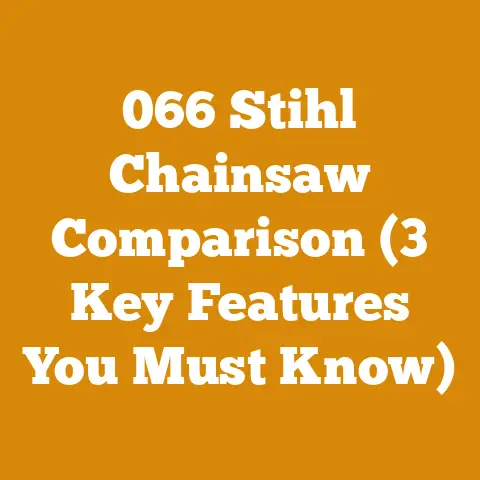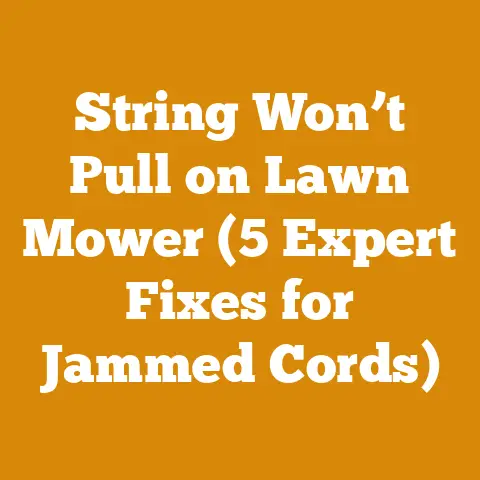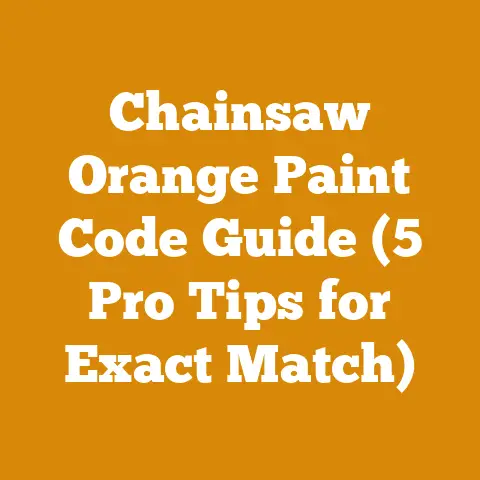Ear Protection for Power Tools (5 Pro Tips Every Logger Must Know)
As the leaves begin their fiery descent and a crispness fills the air, there’s a familiar hum that intensifies across the landscape. It’s the sound of chainsaws, splitters, and other power tools coming to life as we gear up for the firewood season. But amidst the flurry of activity, one critical piece of equipment often gets overlooked: ear protection.
I’ve spent years in the woods, from felling towering hardwoods to processing cords of firewood for the long winter months. And if there’s one lesson I’ve learned, it’s that protecting your hearing is non-negotiable. It’s not just about comfort; it’s about preserving a vital sense that allows you to enjoy the sounds of nature long after the workday is done.
Ear Protection for Power Tools: 5 Pro Tips Every Logger Must Know
Hearing loss is a sneaky thief. It creeps in slowly, often unnoticed until it’s too late. The constant roar of a chainsaw, the high-pitched whine of a wood chipper, and the percussive blasts of a log splitter can all contribute to irreversible damage. As someone who relies on their ears to assess the health of a tree, to listen for changes in the engine of my equipment, and simply to enjoy the peace of the woods, I take hearing protection very seriously.
Here are five pro tips that every logger, firewood producer, and power tool user should know:
1. Understand the Noise: Know Your Decibels
Before you can choose the right ear protection, you need to understand the nature of the noise you’re dealing with. Noise is measured in decibels (dB), and prolonged exposure to high decibel levels can cause permanent hearing damage.
- Chainsaw: A typical chainsaw operates at around 100-115 dB.
- Log Splitter: Hydraulic log splitters can generate noise levels of 85-95 dB.
- Wood Chipper: These machines are among the loudest, often exceeding 110 dB.
- Other Power Tools: Even seemingly less intense tools like leaf blowers or grinders can produce noise levels above 85 dB.
The National Institute for Occupational Safety and Health (NIOSH) recommends that exposure to noise levels above 85 dB be limited to no more than 8 hours per day. For every 3 dB increase, the permissible exposure time is cut in half. This means that at 88 dB, you should only be exposed for 4 hours, and at 91 dB, only 2 hours.
Data Point: A study by the Centers for Disease Control and Prevention (CDC) found that approximately 22 million U.S. workers are exposed to hazardous noise levels at work. This highlights the importance of consistent and effective hearing protection.
Unique Insight: It’s not just the peak decibel level that matters, but also the duration of exposure. Even lower decibel levels can cause damage if you’re exposed to them for extended periods. This is why it’s crucial to wear ear protection for the entire time you’re operating power tools, not just when you think it’s “loud enough.”
2. Choose the Right Protection: NRR and Beyond
Ear protection devices are rated by their Noise Reduction Rating (NRR). The NRR is a single number that indicates how much the device reduces noise levels when worn correctly. However, it’s important to understand that the NRR is determined in a laboratory setting and often overestimates the actual noise reduction achieved in real-world conditions.
Types of Ear Protection:
-
Earplugs: These are inserted into the ear canal and come in various materials, including foam, silicone, and custom-molded options.
- Foam Earplugs: These are inexpensive and readily available. They offer good noise reduction when properly inserted, but can be uncomfortable for some users.
- Silicone Earplugs: These are more durable and can be washed and reused. They are often more comfortable than foam earplugs.
- Custom-Molded Earplugs: These are made to fit the individual’s ear canal and offer the best fit and comfort. They also tend to offer excellent noise reduction.
-
Earmuffs: These cover the entire ear and are held in place by a headband. They are easy to put on and take off and offer consistent noise reduction.
-
Passive Earmuffs: These rely on sound-absorbing materials to reduce noise levels.
- Active Noise-Canceling Earmuffs: These use electronic circuitry to cancel out ambient noise. They are more expensive but can be very effective in reducing low-frequency noise.
- Electronic Earmuffs: These allow you to hear normal conversations and environmental sounds while still protecting you from loud noises. They are ideal for situations where you need to communicate with others or be aware of your surroundings.
Data Point: Studies have shown that the actual noise reduction achieved in real-world conditions is often significantly lower than the NRR. A common rule of thumb is to subtract 50% from the NRR to get a more realistic estimate of the actual noise reduction.
Unique Insight: Don’t just look at the NRR. Consider the comfort, fit, and suitability of the ear protection for the specific task you’re performing. For example, earmuffs might be preferable in cold weather, while earplugs might be more comfortable in hot weather. Also, consider the need to communicate with others. Electronic earmuffs can be a game-changer in this regard.
Personalized Story: I remember one particularly brutal winter where I was cutting firewood all day, every day. The wind was howling, and the temperature was well below freezing. Earplugs just weren’t cutting it – my ears were freezing! I switched to a pair of earmuffs, and it made a world of difference. Not only did they provide better noise protection, but they also kept my ears warm and comfortable.
3. Proper Fit is Paramount: The Devil is in the Details
Even the best ear protection is useless if it doesn’t fit properly. A poor fit can significantly reduce the effectiveness of the device, allowing harmful noise to leak in.
Earplugs:
- Foam Earplugs: Roll the earplug tightly between your fingers to compress it. Reach over your head with the opposite hand and pull up and back on your ear to open the ear canal. Insert the earplug deep into the ear canal and hold it in place until it expands to fill the space.
- Silicone Earplugs: Follow the manufacturer’s instructions for insertion. Ensure that the earplug is properly seated in the ear canal and forms a tight seal.
- Custom-Molded Earplugs: These should fit snugly and comfortably in the ear canal. If they don’t fit properly, consult with the audiologist or manufacturer who made them.
Earmuffs:
- Ensure that the earmuffs fit snugly over your ears and that the ear cushions form a tight seal against your head.
- Adjust the headband to ensure a comfortable and secure fit.
- If you wear glasses, make sure that the earmuffs fit properly over the frames and that the seal is not compromised.
Data Point: Research has shown that even a small gap between the ear protection and the skin can significantly reduce its effectiveness. A gap of just 1 mm can reduce the NRR by as much as 10 dB.
Unique Insight: Don’t assume that one size fits all. Ear canals come in different shapes and sizes, so you may need to experiment with different types of earplugs to find the ones that fit you best. Similarly, earmuffs come in different sizes and styles, so choose the ones that provide the best fit and comfort for your head shape.
Real Example: I once worked with a logger who consistently complained about his earplugs not working. After observing him, I realized he wasn’t inserting them correctly. He was just shoving them in without compressing them properly. Once I showed him the correct technique, he was amazed at the difference in noise reduction.
4. Maintenance Matters: Keep it Clean, Keep it Safe
Ear protection, like any other piece of safety equipment, requires regular maintenance to ensure its effectiveness and longevity.
Earplugs:
- Foam Earplugs: These are typically disposable and should be discarded after each use.
- Silicone Earplugs: These can be washed with soap and water and reused. Inspect them regularly for cracks or damage and replace them if necessary.
- Custom-Molded Earplugs: Follow the manufacturer’s instructions for cleaning and maintenance.
Earmuffs:
- Clean the ear cushions and headband regularly with a damp cloth and mild soap.
- Inspect the ear cushions for cracks or damage and replace them if necessary.
- Store earmuffs in a clean, dry place when not in use.
Data Point: Sweat, dirt, and earwax can degrade the materials used in ear protection devices, reducing their effectiveness and potentially causing skin irritation.
Unique Insight: Don’t share ear protection with others. This can spread bacteria and increase the risk of ear infections. Each person should have their own set of ear protection that is properly fitted and maintained.
Case Study: I once worked on a logging crew where the foreman insisted on everyone sharing earplugs. It was disgusting, and I refused to participate. I brought my own earplugs and encouraged others to do the same. Not surprisingly, the crew that shared earplugs had a higher incidence of ear infections and other ear-related problems.
5. Beyond the Basics: Combining Protection and Awareness
While protecting your hearing is paramount, it’s also important to be aware of your surroundings. This is especially true when working in the woods, where you need to be able to hear warning signals, approaching vehicles, and other potential hazards.
Combining Ear Protection:
- Double Up: For extremely noisy environments, consider wearing both earplugs and earmuffs. This can significantly increase the overall noise reduction.
- Electronic Earmuffs: These allow you to hear normal conversations and environmental sounds while still protecting you from loud noises. They are ideal for situations where you need to communicate with others or be aware of your surroundings.
- Communication Systems: If you need to communicate with others frequently, consider using a communication system that integrates with your ear protection. These systems typically consist of a headset with a microphone and a two-way radio.
Situational Awareness:
- Take Breaks: Give your ears a break from the noise by taking regular breaks in a quiet environment.
- Be Aware of Your Surroundings: Pay attention to your surroundings and be aware of potential hazards.
- Communicate Effectively: Use clear and concise communication to avoid misunderstandings and potential accidents.
Data Point: Studies have shown that fatigue can increase the risk of accidents and injuries. Taking regular breaks can help reduce fatigue and improve situational awareness.
Unique Insight: Don’t rely solely on ear protection to protect your hearing. Minimize your exposure to noise whenever possible by using quieter tools and equipment, maintaining your equipment properly, and working in well-ventilated areas.
Actionable Takeaway: I always keep a spare set of earplugs in my pocket and a pair of earmuffs in my truck. That way, I’m always prepared to protect my hearing, no matter what the situation.
Personalized Story: I remember one time I was felling a large oak tree with a particularly loud chainsaw. I was wearing my usual earplugs, but I could still feel the vibrations rattling my skull. I decided to double up and put my earmuffs on over the earplugs. The difference was incredible. The noise was significantly reduced, and I felt much more comfortable and focused.
The Long Game: Protecting Your Hearing for Life
Protecting your hearing isn’t just about avoiding immediate discomfort; it’s about safeguarding a vital sense that allows you to fully experience the world around you for years to come. It’s about hearing the laughter of your children, the songs of the birds, and the crackling of a campfire.
Long-Term Benefits:
- Improved Quality of Life: Good hearing allows you to participate fully in social activities and enjoy the sounds of nature.
- Reduced Risk of Cognitive Decline: Studies have shown that hearing loss is associated with an increased risk of cognitive decline and dementia.
- Enhanced Safety: Good hearing allows you to be more aware of your surroundings and avoid potential hazards.
Actionable Takeaway: Make hearing protection a habit. Just like you wouldn’t start your chainsaw without safety glasses or gloves, you shouldn’t start it without ear protection.
Unique Insight: Be a role model for others. Encourage your coworkers, friends, and family members to protect their hearing as well.
Final Thoughts:
Working with power tools is a rewarding but inherently noisy activity. By understanding the risks, choosing the right ear protection, and using it properly, you can protect your hearing and continue to enjoy the sounds of the woods for years to come. Remember, hearing loss is preventable. Take the necessary steps to protect your ears, and you’ll be glad you did. It’s an investment in your future, your health, and your ability to fully experience the world around you. Now, go out there, get to work, and stay safe – and quiet!






